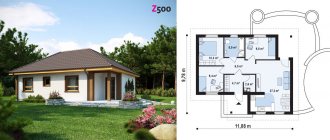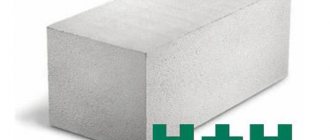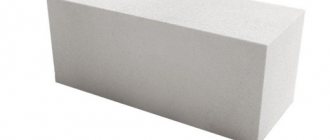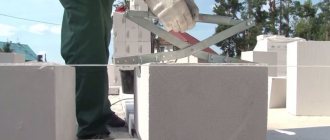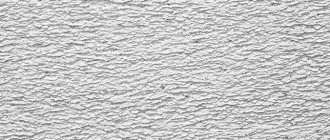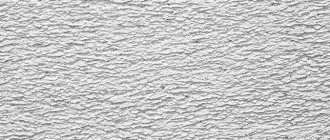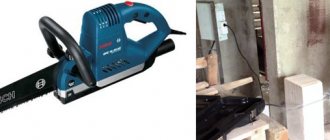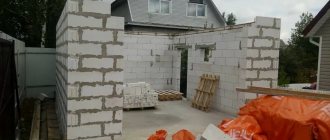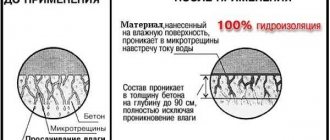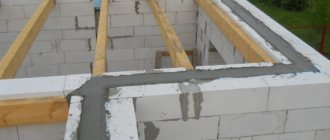Aerated concrete is a material that is obtained from a mixture of cement and sand to which reagents are added, which, when interacting with cement, form foam. Powdered aluminum or paste made from it is used as reagents for aerated concrete. As a result of the reaction of aluminum powder and cement (or lime), pores are formed in concrete - air bubbles, evenly distributed throughout the volume. The bubbles are enclosed in a shell of binder - cement or lime. This type of concrete is called cellular or lightweight.
Manufacturers are constantly offering new solutions, trying to reduce the cost of building materials and simplify the construction work themselves as much as possible. And cellular concrete is one of such solutions. So, aerated blocks are a variation of porous concrete, which is, in principle, an artificial stone containing spherical cells .
To make the material, quartz sand, cement and special gas-forming agents (suspensions or aluminum-based pastes) are used. lime, ash or gypsum are additionally used . The resulting mass is subjected to prolonged temperature exposure under high pressure conditions. The solution foams due to a chemical reaction, and hardens with pores already formed.
In accordance with GOST 30244, building materials are characterized by fire resistance, and structures built from these materials are characterized by fire hazard. Fire resistance is the ability of building materials to limit the spread of fire and maintain performance properties at high temperatures. The numerical expression of fire resistance is the fire resistance limit, which is indicated by the REI index.
Fire resistance limit is a parameter showing the time in minutes before the onset of limiting states in a fire:
- R - loss of bearing capacity;
- E - loss of structural integrity;
- I - thermal insulation of the structure or the extreme point of fire.
The fire resistance limit of aerated concrete blocks depends on their density and geometric dimensions. For example, the fire resistance limit of aerated concrete blocks is 100 mm REI180. This means that even a thin wall made of aerated block will ignite when exposed to a critical temperature only after 3 hours. The block structure will lose its integrity and collapse after 3 hours of continuous burning. It's hard to imagine the fire lasting that long. The fire resistance level of 200 mm aerated concrete blocks is even higher - REI240. Moreover, the lower the density of aerated concrete (D), the higher the fire resistance limit. This is explained by a decrease in the thermal conductivity of blocks with decreasing density. In turn, a decrease in thermal conductivity leads to a decrease in dehydration - the breakdown of water into hydrogen and oxygen, and, as is known, without oxygen the combustion process is impossible.
Fire technical characteristics and fire resistance of structures
The high fire resistance limit of aerated concrete is the reason that all aerated concrete structures, in accordance with SP 112.13330, belong to class K0 - non-fire hazardous. The degree of fire resistance of a wall made of aerated concrete blocks is 1 (first), i.e. the tallest. In case of fire, the material does not emit toxic or any other gases. Such a high fire resistance of aerated concrete makes it possible to build fire walls and special protective structures for buildings made of more fire-hazardous materials.
In other words, if a fire occurs, aerated block structures will not only not burn, but will also protect less fire-resistant elements from burning. If you find the corresponding photographs on the Internet, you can see that the aerated concrete remained almost intact after the fire, while the wooden roof and decoration of the house were completely burned. The maximum that can be found in photographs after a fire of an aerated concrete structure is a network of cracks from shrinkage due to the removal of crystallized moisture. In this case, the depth of cracks is usually insignificant - 3-10 mm.
Flammability of building materials
Our homes are filled with flammable plastic and wood. When choosing a building project, you should know: is the house capable of becoming a fortress in a critical situation? Before purchasing building materials, it would be good to get answers to two questions:
- How well do they promote combustion?
- How reliably will walls, columns and ceilings built from purchased building materials be able to protect residents from the effects of destructive fire factors?
The answer received to the first question means that you have clarified for yourself the degree of fire hazard of the purchased material. The answer to the second is that you were able to determine the degree of fire resistance of the building structure.
According to the requirements of SNiP 21-01-97, all building materials can be characterized by varying degrees of fire hazard.
Aerated concrete blocks are among the champions in terms of non-flammability. Their basis is a natural mineral, natural stone. This is a fireproof material that:
- does not smolder,
- does not ignite,
- does not char,
- does not spread smoke
- does not emit toxic gases.
Portland cement, ash additives, sand - not only do not support, but also prevent combustion. Therefore, aerated concrete as a material is completely safe in terms of fire.
Fire resistance indicators of autoclaved aerated concrete
What temperature can a gas block withstand if, in accordance with GOST 30244-94, it belongs to the group of fireproof building materials and the class of non-combustible? According to the state standard, wall materials are classified as non-combustible when 3 parameters are combined during testing:
- temperature increase during combustion no more than 50 ℃
- weight loss of the tested samples does not exceed 50%;
- The duration of stable burning with an open flame does not exceed 10 seconds.
This means the following: under the influence of ultra-high temperatures (above +1000 ℃), an aerated block, the fire resistance limit of which is below these temperatures, can burn, but at the same time the strength of the fire’s thermal power will increase by no more than +50 ℃. A gas-block house will burn with an open flame for no more than 10 seconds, and then the flame will either die out or spread to other more flammable materials.
Fire safety technical characteristics of autoclaved aerated concrete:
| Characteristic | Meaning |
| Fire resistance REI | 180…240 |
| Flammability class | NG (non-flammable) |
| Limit temperature before failure | +700 ℃ |
| Emission of acrid smoke | No |
| Release of toxins during combustion | No |
| Hazard class of r/b structures | K0 (fireproof) |
Fire resistance of aerated concrete blocks
Aerated concrete blocks are a building material made from cement, quartz sand and gas-forming admixtures. Pores (empty spaces) with a diameter of 1 to 3 millimeters are evenly distributed throughout the entire volume of the block.
Aerated concrete is very easy to process without the use of specialized tools. Also, over time, it becomes harder and more stable, which significantly increases the reliability of the created structure.
Quite often, people choose this material when constructing premises with a high risk of fire hazard.
Resistant to real fires
During a real fire, the temperature ranges from 650 to 1350°C, and depends only on the external environment and the location of the fire. For example, during an external fire the temperature does not rise above 680°C due to heat exchange with the external environment.
In a closed room, the fire temperature can reach 900°C, provided that there are no flammable substances in the room.
If there are still flammable substances in the room, the temperature can rise significantly (for gases up to 1300°C/for liquids up to 1350°C).
It is the interior finishing materials that play a significant role in the outcome of a fire, so if you are concerned about the issue of fire resistance, focus on non-flammable and non-toxic finishing materials - plaster, etc.
It should be noted that extinguishing a fire with cold water leads to additional loss of strength in heated blocks, while their natural cooling allows partial strength to be restored.
Thus, after a fire, it is necessary to conduct an examination and establish the level of changes in aerated blocks, namely the compressive strength (MPa), which determines the possibility of using the material as a load-bearing wall.
Comparison with ordinary concrete
Aerated concrete is many times more fire resistant than conventional concrete. Irreversible changes in ordinary concrete begin to occur already at temperatures from 400 to 700°C for an exposure duration of 5 to 20 minutes. The impact causes through holes, cracks and spalling to form in the concrete.
Such fragility arises from uneven heating of the various impurities that make up the concrete itself. Steam forms inside and negatively affects the structure of the material, which leads to the formation of multiple cracks inside the concrete.
What changes can occur when heated?
The fire resistance of a wall made of aerated concrete blocks is quite high, but what happens to the material if a fire does happen? What temperature can an aerated concrete block withstand and how do its properties change under the influence of fire? This can be judged from laboratory tests conducted in accordance with GOST 30244-94. So, when a gas block is heated, changes occur in its structure:
- +100 C. Strength increases to 2 MPa, while volume, weight, color and other characteristics remain unchanged. It is at this temperature that autoclaved aerated concrete is produced.
- +300 C. Strength decreases slightly - to 1.8 MPa, which is higher than before heating. Weight decreases by 2%. The color of the blocks changes - it becomes darker. There is no damage to the surface.
- +500 C. Strength decreases to 1.6 MPa, weight - by 4%. The material turns gray, but there is no visible damage.
- +700 C. Strength is 90% of the nominal - 1.6 MPa, weight is 6% less than the original. The blocks are dark gray in color; cracks up to 3 mm deep are noticeable on the surface.
- +900 C. Strength drops to 1.2 MPa, which is 7% lower than the original. The mass of the material is reduced by 7%, the blocks are reduced in volume by 10%. The color of the material is light gray, there are many cracks on the surface up to 10 mm deep.
- +1000 C. The masonry of aerated blocks is destroyed. Strength is 0 MPa. The color of aerated concrete is bright white, the surface has deep cracks.
Thus, answering the question of what temperature aerated concrete can withstand, we can safely say that the cellular material can withstand temperatures up to +900 ℃. If the fire temperature was below +700 ℃, then the gas blocks can be reused.
Products
It is made from a mixture of cement, water, quartz sand, lime and aluminum powder/or paste, due to which gas formation occurs in the solution. These components undergo special preparation - they are cleaned, mixed, and thoroughly crushed.
Gas silicate is produced on specialized modern equipment, thanks to which special conditions are created to impart strength to the composition during hardening.
In our climate, people have been building from autoclaved aerated concrete for more than 70 years. In the Baltic part of Europe, buildings made of autoclaved aerated concrete from the 1930s are known. buildings (which is important - without external decoration), which have survived to this day without destruction.
Excellent thermal insulation
Thanks to precise geometric dimensions and “fine-seam masonry” technology, the gap between the blocks is about 3 mm, which prevents the formation of “cold bridges” and reduces heat losses.
Along with a small gap between the blocks, the presence of air in the pores ensures low thermal conductivity of gas silicate (and, accordingly, low thermal inertia). Therefore, living in a properly built house made of gas silicate, you will ensure minimal heating costs in winter and coolness indoors in hot summer.
In addition, due to its structure with evenly distributed pores, gas silicate has the so-called. isotropy, that is, the same thermal conductivity properties in all directions, whereas, for example, ceramic thermally efficient bricks with vertical voids have different thermal conductivity in all directions.
Reduce construction time and costs
With a large size and low volumetric weight, on average, 1 gas silicate block replaces 15-20 bricks, due to which workers will have to perform 15-20 times fewer operations than when laying a brick wall of the same size.
Fire safety indicators
| Fire safety indicators | Concrete B10…B40 | Foam concrete | Aerated concrete |
| Class | NG | NG | NG |
| Fire resistance REI | 45…60 | 120 | 180…240 |
As can be seen from the table, the fire resistance limit of 100 mm aerated concrete blocks is 5 times higher than that of ordinary concrete and 1.5 times higher than that of foam concrete. Where concrete is already on fire, a wall of aerated concrete blocks successfully contains the flames and prevents the fire from spreading. Therefore, to the question: does aerated concrete burn, there is a clear answer - it doesn’t burn. But under the influence of temperatures above +900 ℃ it is destroyed.
gasobeton.ru full-houses.ru youtube.com
Fire resistance limit of aerated concrete blocks - Safety Portal
It is made from a mixture of cement, water, quartz sand, lime and aluminum powder/or paste, due to which gas formation occurs in the solution. These components undergo special preparation - they are cleaned, mixed, and thoroughly crushed.
Gas silicate is produced on specialized modern equipment, thanks to which special conditions are created to impart strength to the composition during hardening.
In our climate, people have been building from autoclaved aerated concrete for more than 70 years. In the Baltic part of Europe, buildings made of autoclaved aerated concrete from the 1930s are known. buildings (which is important - without external decoration), which have survived to this day without destruction.
Fire resistance of aerated concrete blocks
Aerated concrete blocks are a building material made from cement, quartz sand and gas-forming admixtures. Pores (empty spaces) with a diameter of 1 to 3 millimeters are evenly distributed throughout the entire volume of the block.
Aerated concrete is very easy to process without the use of specialized tools. Also, over time, it becomes harder and more stable, which significantly increases the reliability of the created structure.
Quite often, people choose this material when constructing premises with a high risk of fire hazard.
Fire resistance of aerated concrete
Aerated concrete does not burn and has a high degree of fire resistance, thereby surpassing ordinary concrete.
This feature is due to the fact that the aerated concrete block consists only of mineral components.
The blocks have the first degree of fire resistance and in the event of a fire, a wall (20 cm) made of aerated concrete can prevent further spread of fire.
The stability of the blocks depends directly on the density of the material.
For example, during the manufacture of aerated blocks, pozzolanic cement (contains various volcanic minerals) can be used, which, albeit slightly, increases fire resistance.
Design Bureau of Gleb Grinfeld
Aerated concrete is non-flammable, and structures made from it are very fire-resistant. To analyze this thesis, let's move from the specific to the general. First pictures, then a little theory. For clarity, I will give examples of a real fire and a laboratory test for fire resistance.
1. Here is a house with aerated concrete walls, in which, due to electrical problems, the interiors of the second floor burned out and the roof, made of wood, burned out.
2. Here is a view of the walls of the former attic. The putty has fallen off, the walls are still alive.
3. Here is the wall close up. The network of cracks is due to shrinkage due to the removal of crystallization moisture. The depth of damage is 3–10 mm.
4. But this is not an inspection of a fire with an uncontrolled combustion regime, but a laboratory experiment. Testing masonry for fire resistance under load. The thickness of the tested masonry is 150 mm. The load on the sample is about 20 tf (aerated concrete D400 B2.5, fragment length is about 3 m).
5. Burners are installed inside the test installation, which ensure an increase in temperature according to a standard schedule, simulating a so-called “cellulose fire”.
6. 46 minutes of unilateral fire impact on the structure. On the “cold” side, the masonry heated up from 13 to 14-15 degrees Celsius (by 1–2 degrees for 45 minutes!), in the “hot” compartment the temperature is already well over 800 degrees.
7. The tests lasted 120 minutes - two hours of active fire exposure. The temperature was raised above 1000 degrees Celsius. The photographs show that the residual luminosity is more active near the adhesive joints and near the framing structures of the test facility. Aerated concrete blocks themselves, as low-thermal conductivity products, glow much less intensely.
8. And finally, the most visual shot. A fragment of dismantled masonry, when looking at which one can see the depth to which the dehydration front of hydrosilicates has advanced - changes have occurred that led to cracking and loss of strength of the material: 30–40 mm in 120 minutes.
At the end of the day, a few general considerations.
Construction in Russia has traditionally been predominantly wooden. Wooden cities periodically burned out, since everything was made of wood - walls, roofs, window shutters, floors, porches, fences, pavements. Dry windy weather, drunkenly dropped coal and - puff! - there is no city of Ryazan.
Therefore, our fire safety standards are very strict. Due to historical experience.
Classification of materials and structures.
The first and simplest classification of materials is by flammability.
On/off. If it burns, how intensely? Accordingly, materials are divided into groups: non-flammable - NG, flammable - from G1 (low-flammable) to G4 (highly flammable). [GOST 30244-94]
For combustible materials, flammability (B1–B4), smoke-forming ability (D1–D4), and smoke toxicity (T1–T4) are also taken into account. Aerated concrete is non-flammable (NG).
Structures made from materials are characterized by fire resistance, which does not really correlate with flammability.
For example, wooden beams are more fire resistant than metal beams, although they do burn. The point is this. Fire resistance is classified according to three criteria
: loss of bearing capacity (R); loss of integrity (E); loss of thermal insulation ability (I). The fire resistance limit for each of the characteristics is estimated in minutes. For example, a structure with R30 EI60 will retain its load-bearing capacity for half an hour and maintain its integrity and thermally insulate the enclosed room for an hour (if there is no load). Let's return to wooden floor beams. In the event of a fire, they ignite quite easily, begin to smoke within the limits of their ability to generate smoke, but continue to carry the load. Therefore, they will always provide the 15 minutes of maintaining load-bearing capacity required for an individual house. During this time, the residents will have time to evacuate the house. Metal floor beams, without special fire protection, easily overheat and “flow” - the steel loses its load-bearing capacity and the floor collapses, along with those on top, on those below.
Let's return, however, to aerated concrete.
Mineral building materials are generally very fire-resistant, but aerated concrete stands out even among them. It is the most fire-resistant material for masonry. Low thermal conductivity protects buried layers from the heat of fire. Therefore, when the outer surface of aerated concrete after an hour and a half of continuous fire loses hydration moisture and calcium hydrosilicates degrade to anhydrous silicates, the inner layers remain in their original integrity.
What we have in relation to aerated concrete:
material -
NG
.
masonry with a thickness of 100 mm - EI180
.
masonry with a thickness of 200 mm - REI240
.
Note
. A decrease in the density of aerated concrete entails a decrease in its thermal conductivity. A decrease in thermal conductivity reduces the rate of advance of the dehydration front. Consequently, a decrease in density increases the fire resistance limit according to characteristics E and I.

